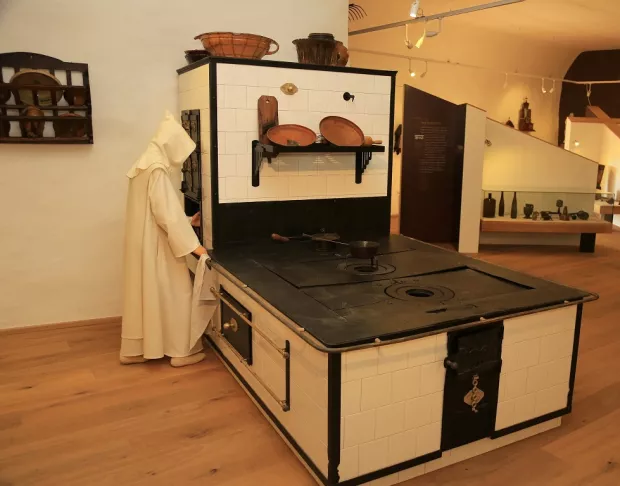A new religious influence was introduced to this region, after the French government disbanded the Trappist monastery of Dumb near Lyon in 1881 and the ‘silent monks’ relocated to the Rajhenburg Castle. The castle was purchase was funded by brother Gabriel Giraud and converted to a monastery dedicated to Mary of Salvation.
On the 21st of April 1881, seven monks arrived at Rajhenburg. They started preparing rooms at the castle for the arrival of new members of the monastic order. Initially, the order was made up exclusively of French monks, but soon, young men from Slovenia started to join them as well. Novices, who chose to join the ranks of fathers underwent strict priestly training; they were clothed in white. Brothers and labourers, on the other hand, wore brown. The training was conducted at the monastery by monks.
Until they took their first, temporary vows, novices underwent various tests to prove they were able to adhere to the demands of strict monastic life.
Their working days lasted 17 hours; they woke up at one or two in the morning. They devoted a little more than six hours a day to prayer and meditation; the same amount of time was dedicated to physical work, and some time was allotted to attending personal needs. One hour a day was relegated to meals and seven to rest.
Among other things, novices were strictly forbidden to communicate either verbally or using body language.
After taking their temporary vows, they were no longer allowed to eat meat fish, or eggs. The only food of animal origin they consumed, was Trappist cheese, which they made themselves at the monastery and was allowed to be eaten on non-fasting days.
The Trappist monks also engaged in a variety of business activities including agriculture, stockbreeding, wine growing, cheese making and fruit growing.
At first they worked their extensive farmland by hand, but soon invested in machinery. They introduced French farming practices to the area thus bringing great innovations and advanced ideas. In 1929, they were the first in Posavje to buy a tractor. The following year they bought a combine harvester for harvesting grain and making bundles. In 1888, they built stables for the breeding of cattle, horses, swine, and poultry. Since the monks predominately refrained from consuming meat, these were bread to sell.
Along with the castle they also purchased land on the nearby Sremič hill, where they cultivated vine-sorts brought over from France. In 1890, they produced high quality red wine as well as sparkling wine.
The Trapists were the first in our region to spray their vineyards against peronospora using blue copperas (ferrous sulphate).
The Trappists were the first in Slovenia to industrially produce chocolate and liqueurs, starting already in 1896. All the machines they needed for said production were brought in from France. At first they ran on gasoline. But because this fuel was too expensive, they built a hydroelectric power plant on the nearby brook Brestanica, which supplied 50 kW of power. This was the first hydroelectric power plant in the Štajerska region.
No more than twenty years after the invention of telephone, the monastery had its own wiring and phone. The chocolate factory added chocolate dragées to the line. Their products were known for their superior quality, as attested by the fact that the Imperial Court at Vienna also bought chocolate bars from the order. They received the honorary title of IMPERIAL from Emperor Franz Joseph, which then became the name of their brand. In 1912, he also presented them with an award honouring the quality of their products and granted them the use of a lion in the symbol of their trademark.
Their initial quantity of chocolate production averaged between six and ten tons per year. They produced the most chocolate (between 50 and 60 tons) between 1938 and 1939. Their chocolate and chocolate products were sold throughout Europe.
Their products also included three varieties of liqueur, Cocoa, Trapistin cheese, and Grand Liquor.
The factory building where the chocolate production line was located, also accommodated a printing house where books, brochures, postcards, covers and labels for chocolate liqueurs were made.
During the Second World War, the castle was occupied by Germans, who transformed Rajhenburg into the biggest transit camp for Slovenes in existence.
In the context of their programme of the deportation of intellectuals, the Germans expelled 35 out of 90 monks from the monastery.
The monks returned after the war, however, the monastery was abolished in 1947. The castle's ownership was transferred to the state. After the monastery closed, some of the monks worked as priests in the Štajerska region, some joined other European Trappist orders, while others still, left monastic life altogether and joined the civil service.
Irena Fürst, Curator
Author of the Exhibition
National Museum of Contemporary History, the Brestanica Branch
